Your Bonus Feature: Nutrition Prescription. (Page 2 of 2. The details, science, and examples.)
“How do you measure body composition change…? Is that just a change on the scale…?”
Excellent question. No, it is not just change on the scale. I use three sources of data to determine your body composition change. Let’s go through them, one by one.
1. Circumference measurements. You’ll take and upload measurements of various parts of your body. I provide instructions on how to do this with a simple tailor’s tape measure.
Usually, a shoulder circumference increase = muscle gain.
A modest gain in your waist circumference could possibly equate to muscle gain in the abdomen, but it also could certainly equate to fat gain.
When you lose fat, you often lose some size everywhere on your body. The objective when losing fat, of course, is to minimize muscle loss. The two charts shown here offer an excellent picture of someone who is successfully losing body fat (me, between 2020 and 2021). I call these charts “successful” because you can see that the size loss in the shoulders is smaller than the size loss in the waist.
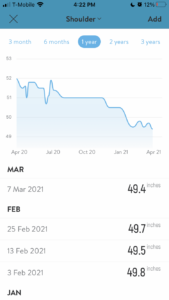
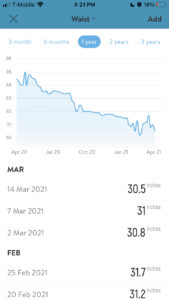
Look at the top half of the screenshots. With the chart on the left, my waist, look at the lefthand side. You’ll see my waist was ~34.5″ in April of 2020. But look over to the righthand side of the same graph. It reflects April of 2021. My waist is 31″. So, in the course of a year, my waist dropped by 2.5″.
Now, do the same scan of the graph on the right; my shoulder circumference. I change from ~ 51.5″, to ~49.5″. That’s just a 2″ decrease.
The waist has dropped more than the shoulders. 2.5 > 2. This is a great thing.
You can also see this phenomena reflected in the shorter-term numbers on the bottom half of the same screenshots. Between February and March of 2021, more size was lost in the waist than in the shoulders.
This is especially impressive considering the waist is already a smaller part of the body than the shoulders.
Hopefully this makes sense.
But even if it sounds confusing, don’t worry. We benefit from having more data to get the full story.
2. The second source of data are your progress photos. Remember that just like your measurements, you’ll upload photos at six week intervals.
Usually, photos are pretty plain to interpret. A more pronounced V-shape in your torso signals an improved shoulder-to-waist ratio. Meaning, you either gained muscle, lost fat, or did both. Regardless of your gender identity, if you aspire for the classic male bodybuilder look, then a more pronounced V-shaped torso is very, very, very desirable. I give a lot of credence to the waist-to-shoulder ratio when it comes to tracking your progress.
Most 10-year-olds could tell you, just at a glance, whether a body is becoming more or less impressive, based on its progress photos. This is because we usually understand, on a primal level, what’s muscle and what’s fat, when we have photos in front of us.
More visible muscle definition = less body fat.
Size growth in shoulders, chest, and arms equates to muscle gained in those areas, usually. (Exceptional circumstances notwithstanding — such as developing obesity.)
If you’re getting bigger, without seeing more muscle definition, then you’re gaining size — possibly muscle — but not losing fat. Not necessarily a problem at all, just a fact.
3. The third source of data is the scale. You may be surprised to see this tool listed last. This is intentional. The scale is useful, but taken on its own, it could misrepresent your changes.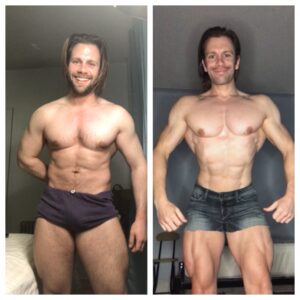 Why? Here is a perfect example.
Why? Here is a perfect example.
This side-by-side image of me compares my body’s progress. I weighed perhaps 10 pounds more on the left.
But my total body composition improved by about 18-22 pounds between these two photos. Why? Because I lost fat and added muscle. If I was only tracking my weight — and not my photos/measurements — I might mistakenly think I’d only changed by 10 lbs.
When in fact, I’d changed by twice that.
Quick word to young hard-gainers/ectomorphs
If you’re in your 20s, active, and wanna gain muscle, listen up.
The formulas in Physique Fundamentals, and/or I personally, will tell you exactly how many grams of protein, carbohydrates, and dietary fat you need to consume daily to achieve muscle gain.
But, sometimes people who are great at working out, and not as successful in following my macronutrient prescriptions, will lose fat, instead of gaining muscle. Especially if they’re young and/or have higher-than-average metabolisms.
Now, losing fat is still a body composition improvement. So, I don’t consider this situation a failure. I’d consider it a success and a valuable learning lesson. Because it could be what motivates you to buckle down with more diligence around your diet.
And that would help you see your original mass-gain goals realized.
Regardless of your age, it’s completely your responsibility to follow my prescriptions to get the changes you desire.
Putting it all together
So, now you know the three sources of data you’ll compile and use.
I hope all this info helps you understand why circumference measurements, photos, and the scale are considered together when assessing your body composition change.
At the end of the day, I study your data and combine it with my intuition and experience to determine your total body composition improvement. By hiring me, you are explicitly agreeing to trust my assessment of your data.
To date, I cannot recall a single client denying my assessment of their data.
I will say that ~ 25% of the time, my high-acheiving clients feel frustrated at the speed of their change. Within the first six months of working with me, they’ve often earned a 6-8 lb body composition improvement. But, they’d hoped it’d look more dramatic.
I think this is because most of us, myself included, focus on the body parts we’re insecure about. Sometimes, these body parts are the most stubborn to change.
That’s why my 10+ Pound Guarantee revolves around overall muscle gained and fat lost, and not specific body parts.
Video Demo of Nutrition Prescription features
Everything in the below video is included in Nutrition Prescription.
(Hint: I find it best to play this video straight from my computer, without using headphones. If you do use headphones, please pardon the light-ish thumping of a neighbor’s instrument.)
Onward? Here’s how DreamBody stacks up against competitors
Or, want more examples of Nutrition Prescription? See below.
Macronutrient Prescription:
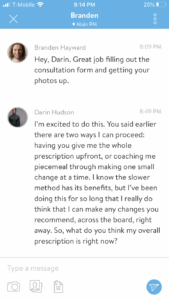
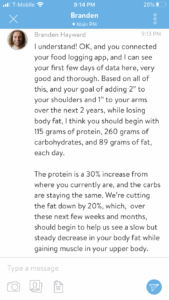
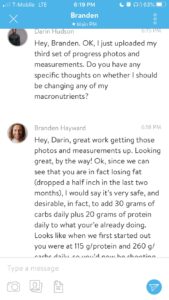
Schedule Consulting:
Struggling to make your workouts a priority? It’s your responsibility to request help. If you do, I will help you.
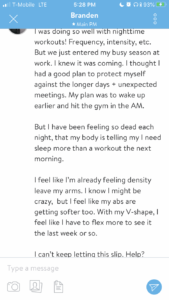


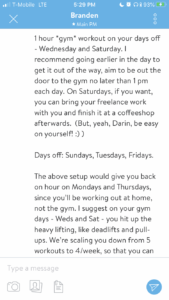

Progress Evaluation, Perspective, and Problem Solving:
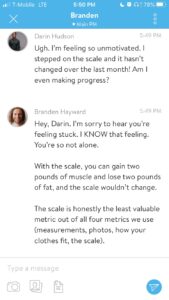
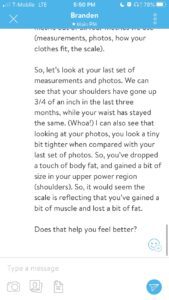
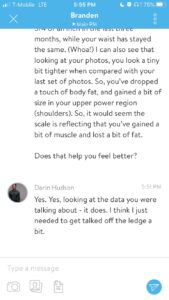
Lifestyle Consulting:
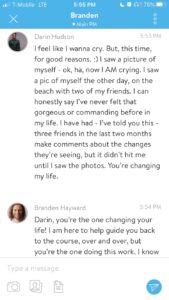
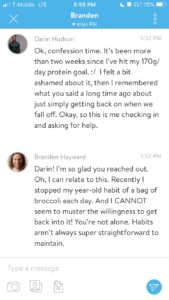
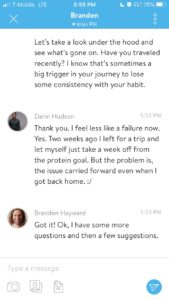
Onward:
DreamBody vs. Others
Rather visit some other DreamBody page? If you’re reading this on a computer, just look up. You’ll find the drop-down menu by hovering over the bright green **DREAMBODY** tab. If you’re on a mobile device, find the **DREAMBODY** drop-down menu by visiting the three horizontal bars in the upper righthand corner of your screen.
